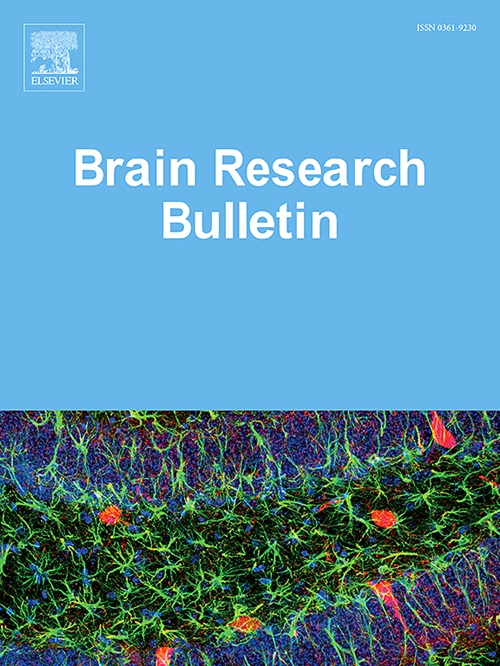患有网络游戏障碍的青少年的反应性攻击的神经生物学相关性。
IF 3.5
3区 医学
Q2 NEUROSCIENCES
引用次数: 0
摘要
背景:以往的研究发现,网络游戏障碍(IGD)与反应性攻击(RA)之间存在明显的正相关,过度使用网络游戏会增加受试者的攻击性。然而,IGD中RA增加的神经机制尚不清楚。本研究探讨了 IGD 青少年反应性攻击的神经生物学基础:这项病例对照研究包括 84 名年轻人,其中有 23 名 IGD 患者、24 名高危参与者和 37 名健康对照者。采用T1加权磁共振成像(MRI)、体素形态计量(VBM)分析评估各组间灰质体积(GMV)的变化,并研究GMV变化与RA评分之间的部分相关性。最后,研究人员还进行了中介分析,以探讨灰质体积的变化是否能调节 IGD 程度与 RA 评分之间的关系:结果:与对照组相比,IGD 组的额叶中回和海马旁回的 GMV 明显增加,而右侧扣带回和扣旁回的 GMV 则明显减少;高危组的额叶中回和海马旁回的 GMV 则明显增加。此外,RA 评分与右侧 DCG 的平均 GMV 呈显著负相关(r=-0.301,p=0.006)。此外,右侧DCG的平均GMV对IGD程度和RA评分之间的相关性有明显的中介作用,这种中介作用的效应大小为22.8%:我们的研究结果为IGD提供了潜在的早期风险生物标志物,并加深了我们对RA与IGD相关神经生物学机制的理解,从而为治疗干预提供了多种潜在途径。本文章由计算机程序翻译,如有差异,请以英文原文为准。
Neurobiological correlates of reactive aggression in young adults with internet gaming disorder
Background
Previous research has found a significant positive correlation between internet gaming disorder (IGD) and reactive aggression (RA), with excessive use of online games increasing aggression in subjects. However, the neural mechanisms underlying increased RA in IGD are unclear. This study explores the neurobiological underpinnings of reactive aggression in young adults with IGD.
Method
This case-control study included 84 young adults, comprised of 23 subjects with IGD, 24 at-risk participants, and 37 healthy controls. Employing T1-weighted magnetic resonance imaging (MRI), voxel-based morphometry (VBM) analysis was conducted to evaluate the gray matter volume (GMV) changes among groups, and the partial correlations between GMV alterations and RA score were investigated. Finally, mediation analyses were conducted to examine whether GMV alterations could modulate the relationship between IGD degree and RA score.
Results
Compared with controls, the IGD group showed significantly increased GMV in the middle frontal gyrus (MFG), parahippocampal gyrus and significantly decreased GMV in the right median cingulate and paracingulate gyri (DCG), while the at-risk group showed significantly increased GMV in the left MFG. In addition, the RA score showed a significant negative correlation (r=-0.301, p=0.006) with the mean GMV of the right DCG. Furthermore, the mean GMV of the right DCG significantly mediated the correlation between degrees of IGD and RA score, and the effect size for this mediation effect was 22.8 %.
Conclusion
Our findings provide potential early risk biomarkers for IGD and enhance our understanding of the neurobiological mechanisms linking RA to IGD, thus facilitating several potential avenues for therapeutic intervention.
求助全文
通过发布文献求助,成功后即可免费获取论文全文。
去求助
来源期刊

Brain Research Bulletin
医学-神经科学
CiteScore
6.90
自引率
2.60%
发文量
253
审稿时长
67 days
期刊介绍:
The Brain Research Bulletin (BRB) aims to publish novel work that advances our knowledge of molecular and cellular mechanisms that underlie neural network properties associated with behavior, cognition and other brain functions during neurodevelopment and in the adult. Although clinical research is out of the Journal''s scope, the BRB also aims to publish translation research that provides insight into biological mechanisms and processes associated with neurodegeneration mechanisms, neurological diseases and neuropsychiatric disorders. The Journal is especially interested in research using novel methodologies, such as optogenetics, multielectrode array recordings and life imaging in wild-type and genetically-modified animal models, with the goal to advance our understanding of how neurons, glia and networks function in vivo.
 求助内容:
求助内容: 应助结果提醒方式:
应助结果提醒方式:


